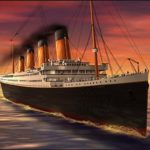
This story was originally told by the Young Asset Managers Group at the 2013 ICOMS (now AM-Peak).
What can we take away from it?
Consider the Titanic. There was poor equipment management – only one pair of binoculars and even that was not with the look out, no safety training for the staff (some of the lifeboats were launched with only a fraction of the passengers they could have held.) Safety regulation then was largely non-existent. Lifeboats were not really considered necessary (the ship was unsinkable) and they occupied space and interfered with the view of the passengers. There was also little operational training either as this would have slowed down the departure date.
The Titanic was a commercial venture and, although it was the latest and most modern of ships, nevertheless the company had been operating ships for years, so there was a certain amount of complacency. Was this the cause of failure : complacency and costs before people?
 The Apollo 7 was also a new venture, but it was a public project. The goal was not simply to get off the launch pad but to take a man into space – and bring him back safely! A year earlier Apollo 1 had suffered a cabin fire during a launch pad test which killed all three crew members. The subsequent inquiry discovered a great number of design and construction flaws – and these problems were corrected, Apollo 7 launched successfully in October 1968. Attention to safety paid off! Pre flight safety checks and operational training won the day. Apollo 7 was not complacent, not commercial and put safety first.
The Apollo 7 was also a new venture, but it was a public project. The goal was not simply to get off the launch pad but to take a man into space – and bring him back safely! A year earlier Apollo 1 had suffered a cabin fire during a launch pad test which killed all three crew members. The subsequent inquiry discovered a great number of design and construction flaws – and these problems were corrected, Apollo 7 launched successfully in October 1968. Attention to safety paid off! Pre flight safety checks and operational training won the day. Apollo 7 was not complacent, not commercial and put safety first.
And there the story could have ended, were it not for Challenger.
Less than 20 years later, in January 1986, the Challenger broke apart 73 seconds into its flight killing all 7 of its crew. The cause, as we all know now, was the O-ringseal which became brittle in low temperatures and disintegrated. The O-rings, as well as many other critical components, had no test data to support any expectation of a successful launch in low temperature conditions. NASA managers had known the design contained a potentially catastrophic flaw in the O-rings since 1977 but failed to address it properly and they disregarded warnings from their engineers about the dangers of launching posed by the low temperatures that morning. There were internal financial pressures to get the launch happening, and they had launched successfully many times before.
So complacency and commerciality can affect us all! Being a publicly funded and operated venture is no protection!
Comment?

The Titanic was marketed as unsinkable. It was designed to be hard to sink. At the time of its collision there was great pressure to make the fastest crossing times. Moving at expected speeds and compensating for vision distance it should not have hit, nor hit as hard. Lifeboat numbers were reduced on the basis that the vessel could not sink as rapidly as it did, due to the internal compartments, what the marketeers termed “unsinkable”.
The O-ring design in the Shuttle had flaws that were apparent from previous launches; flaws that were identified and reported and in the process of being corrected with redesigned mounting.
Both tragedies arose from internal organisational pressure and terrible decisions made by people with full access to information.